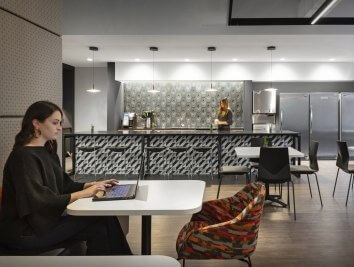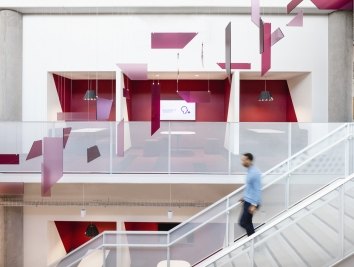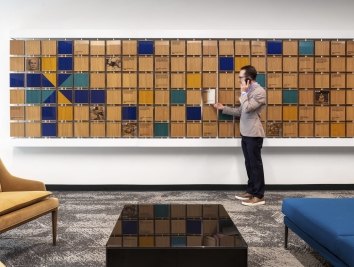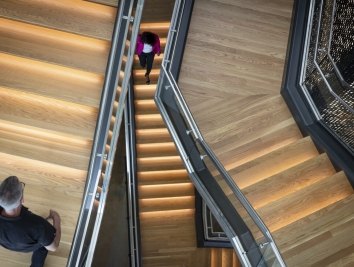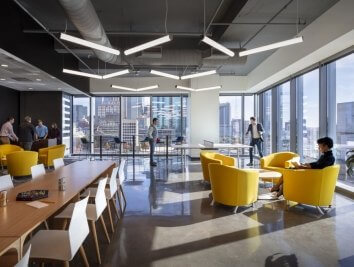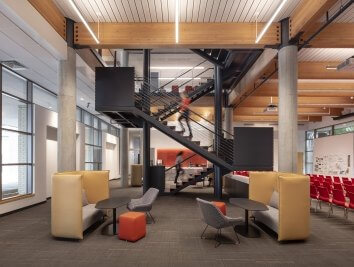Perspectives on the Power of Place
Remote Learning and the Future of Work — Observations from the House of Euscher
As an interior designer, I firmly believe that place matters. My professional focus on workplace design grows from that belief and drives me toward creating places that are not only functional and beautiful but also support interactions between people to build relationships and enrich our lives at work. In the case of my children, their lives at school.
I am blessed with four children, each with their own gifts and learning styles, and each with their own perspective on the strange world of remote learning that they were all thrust into in the spring of 2020. Both of my college-age kids are in performing arts majors and my youngest child started her freshman year at the High School for the Performing and Visual Arts. Each of them had challenges with finding new ways to practice their art, to learn effectively, and to connect with their fellow performers. I was inspired by the teachers and students in their determination to overcome obstacles and find ways to perform “together” through creative deployments of technology — stage plays recorded on iPhones and stitched together, and orchestras assembled by electronically layering one solo recording on another one at a time.
As I said, I believe that place matters, and for me, I worked better at home when I separated work from home life by changing rooms. Without my suggesting it, my two younger kids at home sought out spaces to “go to school” that were different from where they were relaxing, sleeping, or eating. This worked well when every kid was online but deteriorated when the classes shifted to a combination of remote and in-person learning. In the mixed class scenario, my daughter found it more difficult to stay engaged with the teacher and the class, and the disparity contributed to low motivation. However, because every child is different, her brother wasn’t as bothered by this and continued to thrive in school while learning from home.
While my kids liked the ability to do “school from anywhere” they all agreed that some material was more difficult to learn in this manner, and they had a difficult time retaining the material. None of them could explain why, but I noticed that when the screens are on all the time, it is hard not to be distracted by everything else around you — goofing off in class is as simple as turning off the camera. Keeping the cameras on and keeping kids engaged all day through a screen was challenging. I know that many of the classes were recorded and my sons agreed that having recorded classes available for reference was beneficial both for review and for asynchronous learning. However, knowing the material is available later made it easier for them to not pay attention during the class time presentation.
My kids tell me that despite the conveniences made available through remote learning they would not choose to do it more than they had to. Not only were assignments more difficult to manage completely online, but they observed a difference between sitting in an in-person lecture compared with the same content presented to a remote audience. While the technology that enabled connection to class also enabled connections outside of class, they would choose being with friends in person and social distanced over connecting remotely, and when the class became more evenly split between in-person and remote, those who were remote felt more socially excluded and disconnected.
The ability to gather people together from remote places and effectively connect will be with us going forward in the design of workplaces. My kids have also taught me valuable lessons about what to consider when thinking of supporting the future of work.
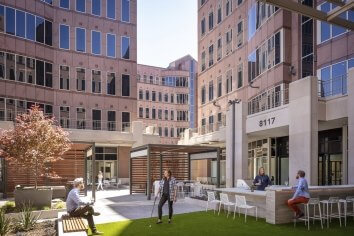
- Cameras On — although it can be distracting to see yourself on screen, keeping the cameras on keeps everyone accountable to each other to pay attention and stay engaged. Turning your camera off signals “I’m going to do something else now.” Seamless conference room technology, plug-and-play features, and added phone rooms make it easier for employees to connect with remote colleagues “face-to-face” and mirror natural in-person interactions.
- Hybrid work: all together even when we aren’t — having some people physically together and some remote separates people by more than distance. People naturally focus their attention on the people in proximity and may inadvertently exclude those participating remotely. Avoid creating an “us and them” situation by keeping everyone on the same “platform” and support video calls with spaces or booths with good lighting and acoustic separation for the best experience — on both ends of the line.
- Naps are good — In the comfort of home, we allow ourselves to nap when we’re tired, rather than pushing through to 5 o’clock. A short rest can refresh your mind and body better than your afternoon caffeine boost and improves mood and productivity. Consider providing a space for quiet contemplation or a mindful reset — and the culture to support the habit. Bonus points for group-led meditation and yoga classes.
- The dog needs a walk and so do you — Just like a nap can leave you feeling refreshed, getting more movement into the daily routine is better for health, wellbeing, and productivity. While on-site fitness centers are popular, interventions like sit-to-stand desks, a centralized stair case, or even attention to circulation paths can help turn functional moments into an opportunity to encourage movement. Exercise your body and let your mind wander — both will benefit.
- Change your space, change your performance — There are reasons we have rooms for sleeping, which are different from rooms for socializing and dining. Same for work — spaces support behaviors through habit, association, and design. More than having good WiFi or enough plugs for our devices, moving from one environment to another helps us focus our energy on the work in our workspace, and disconnected from it when we leave. Prioritize having a variety of settings and a mix of furniture types to allow employees to select the right environment for the task at hand. Get creative — hammocks, rolling stools, ergonomic chairs, cozy sofas, and cocooned chairs all have a place!
- Why would I drive 45 minutes to work when I can walk there in 45 seconds? — Remote working and learning has been tested at a scale that would have never been possible in one company or school. We have seen the benefits of cutting our commutes in lowering stress and giving more time back for family and personal pursuits. Workplaces will need to compel people to gather in shared spaces that provide benefits and features that can’t be found at home. This is the time to consider which amenities matter most for your employees — perhaps an option to cater take-home dinners, a concierge service for dry cleaning and deliveries, on-site childcare, or even a dog run.
- Better together – Collaboration Technology has taken a quantum leap forward as tech companies sought ways to simulate the tools and interactions integral to collaborative work. Virtual White Boards and “sticky notes” that remote users can add to a shared “board” , video conference calls and “break out rooms” are all analogues to collaborative work performed by people in a shared space. The tech both enables remote participation and illustrates the need for people to come together to exchange ideas and work toward a shared goal. The future workplace will need to satisfy the need to gather in person as well as support being together virtually across distances and time zones.
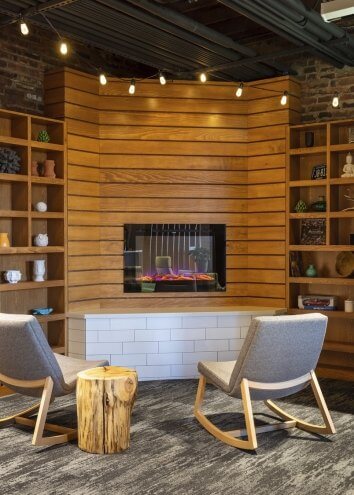
Part of the power of place is the sense of belonging that it creates. For students, the classrooms are important, but also are the in-between spaces where the social dynamics of school happen. These are places where students connect with fellow students and develop an affinity for the place and the people in it. School pride and school spirit are formed in places where students feel they belong to a community — something bigger than themselves. Ideas are shared and friendships grow by spending time together in a shared space. The ways my kids showed me how important place is to them inspires me to create workplaces that encourage connection to others and create a sense of belonging and communities with a shared purpose.
TheSquare Ep 22 · What Remains — Interiors
Cheyne Brown and Rae’Van Parson from Corgan’s Workplace Strategy Team explore the immediate and lasting impacts of COVID-19 on how we experience and perceive the spaces around us, the ways employee expectations and behaviors have evolved, and the opportunities design has to create a more empathetic, seamless and responsive workplace. From integrated amenities and decentralized functions to reestablishing trust in public spaces, listen in on the renewed value and possibilities of office design.





